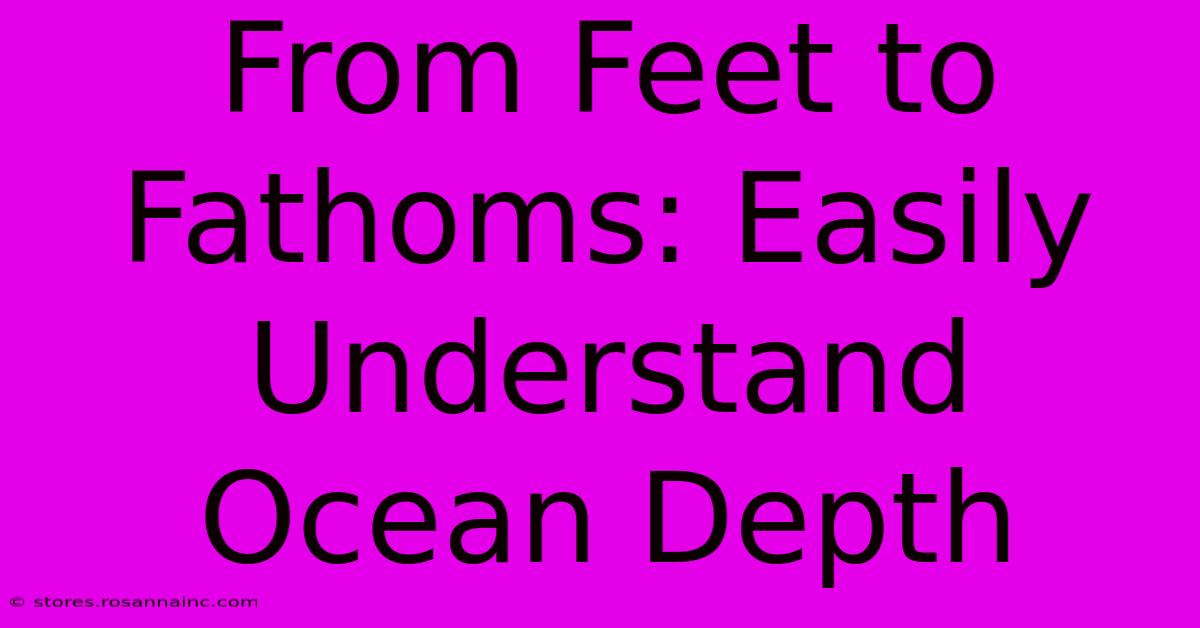From Feet To Fathoms: Easily Understand Ocean Depth

Table of Contents
From Feet to Fathoms: Easily Understand Ocean Depth
The ocean. Vast, mysterious, and incredibly deep. Understanding ocean depth isn't just about knowing numbers; it's about grasping the sheer scale of this underwater world and the diverse life it supports. This article will guide you through the various ways we measure ocean depth, the different zones defined by depth, and why understanding these depths matters.
Measuring the Mysterious Depths: Techniques and Tools
For centuries, humans have strived to measure the ocean's depths, progressing from rudimentary techniques to sophisticated technology. Early methods involved weighted lines, offering a relatively simple, albeit limited, understanding. Today, however, we utilize several advanced methods:
1. Echo Sounding (Sonar): The Workhorse of Depth Measurement
Echo sounding, or sonar (Sound Navigation and Ranging), is the most common method used today. It works by emitting sound waves from a ship and measuring the time it takes for the sound to bounce off the ocean floor and return. The time it takes reveals the distance, thus the depth. This technology allows for rapid and extensive mapping of the ocean floor, providing crucial data for navigation, resource exploration, and scientific research.
2. Multibeam Sonar: Creating Detailed 3D Maps
While echo sounding provides a single line of depth data, multibeam sonar uses multiple sound beams to create a swath of data across the ocean floor. This creates detailed three-dimensional maps, providing a much more complete picture of the underwater landscape. These detailed maps reveal features like underwater mountains, canyons, and even the smallest of seabed details.
3. Satellite Altimetry: Measuring Ocean Surface Topography
Believe it or not, satellites play a critical role in understanding ocean depth. Satellite altimetry measures the height of the ocean surface. While it doesn't directly measure the depth of the ocean floor, it detects subtle variations in the surface caused by underwater features like seamounts and trenches. This indirect measurement provides valuable insights into the underlying topography.
Exploring the Ocean's Vertical Zones: From Sunlit Shores to Abyssal Plains
The ocean isn't a uniform environment; it's stratified into distinct zones based on depth, each with unique characteristics and inhabitants:
1. The Sunlit Zone (Epipelagic): Life in Abundance
This zone, extending from the surface down to about 200 meters (656 feet), receives ample sunlight, supporting a rich diversity of marine life, including phytoplankton, zooplankton, and a vast array of fish and marine mammals. Photosynthesis thrives here, forming the base of the marine food web.
2. The Twilight Zone (Mesopelagic): A Realm of Dim Light
Extending from 200 to 1000 meters (656 to 3281 feet), the mesopelagic zone receives minimal sunlight. Creatures here have adapted to low-light conditions, often exhibiting bioluminescence – the ability to produce their own light. Many deep-sea fish and invertebrates call this zone home.
3. The Midnight Zone (Bathypelagic): Perpetual Darkness
From 1000 to 4000 meters (3281 to 13,123 feet), the bathypelagic zone is characterized by perpetual darkness, crushing pressure, and extremely cold temperatures. Life is sparse but fascinating, with unique adaptations allowing organisms to survive in this extreme environment.
4. The Abyssal Zone (Abyssopelagic): The Deepest Depths
This zone, stretching from 4000 to 6000 meters (13,123 to 19,685 feet), is the largest part of the ocean. It's characterized by extreme pressure, cold temperatures, and a scarcity of food. Life here is highly specialized, often based on scavenging or chemosynthesis.
5. The Hadal Zone: The Trenches
The deepest parts of the ocean, the hadal zone (below 6000 meters or 19,685 feet), are found within ocean trenches. These are some of the most extreme environments on Earth, characterized by immense pressure and total darkness. Unique organisms have adapted to these extraordinary conditions.
Why Understanding Ocean Depth Matters
Understanding ocean depth is crucial for numerous reasons:
- Marine Conservation: Knowing the depths helps in protecting vulnerable habitats and marine species.
- Resource Management: It's essential for exploring and managing valuable resources like minerals and oil.
- Climate Change Research: Deep-sea ecosystems play a crucial role in the global carbon cycle, and understanding their depths is key to studying climate change impacts.
- Navigation and Safety: Accurate depth measurements are critical for safe navigation.
From the sunlit surface to the crushing depths of the hadal zone, the ocean's depth reveals a world of wonder and complexity. By understanding the methods we use to measure it and the diverse zones it encompasses, we can better appreciate the vastness and importance of this vital ecosystem.

Thank you for visiting our website wich cover about From Feet To Fathoms: Easily Understand Ocean Depth. We hope the information provided has been useful to you. Feel free to contact us if you have any questions or need further assistance. See you next time and dont miss to bookmark.
Featured Posts
-
Is Fuego En La Sangre Holding You Back Find Out Now
Feb 09, 2025
-
Inter Miami Cruises Past Olimpia 5 0
Feb 09, 2025
-
Unwind And Recharge At The John J Tyler Arboretum
Feb 09, 2025
-
Navigating Adolescence With The Perks Of Being A Wallflower
Feb 09, 2025
-
When Owning It Matters Most The Power Of Possession
Feb 09, 2025
